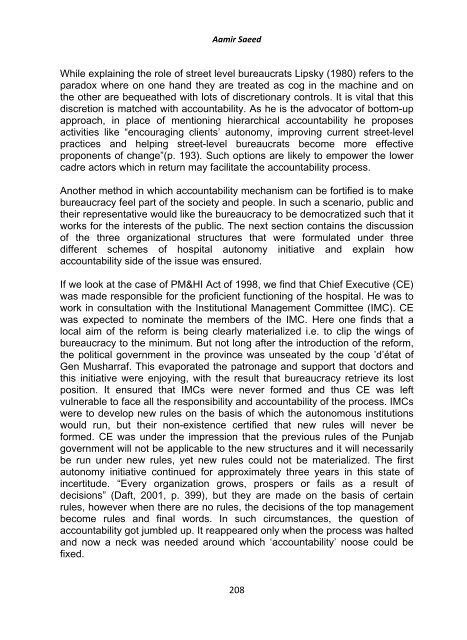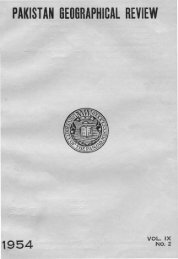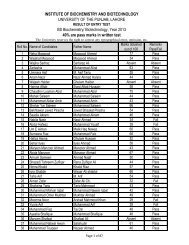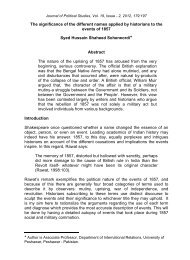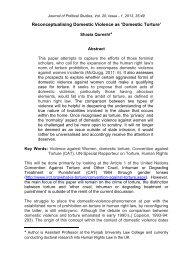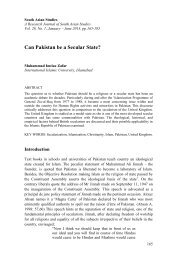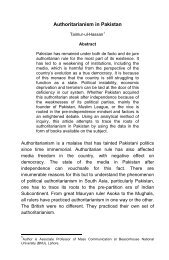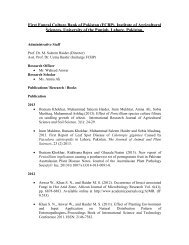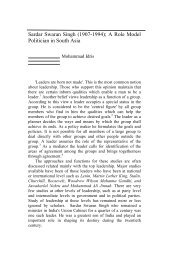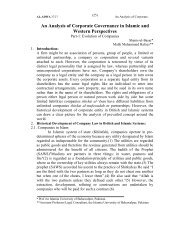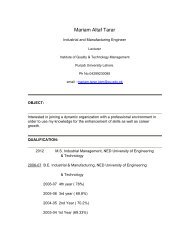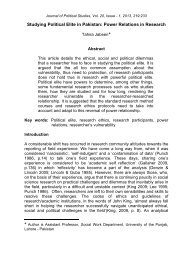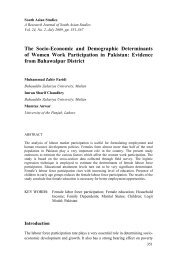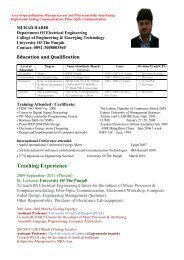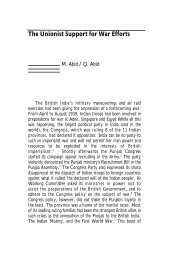Continuation of Colonial Policies by Aamir Saeed - University of the ...
Continuation of Colonial Policies by Aamir Saeed - University of the ...
Continuation of Colonial Policies by Aamir Saeed - University of the ...
You also want an ePaper? Increase the reach of your titles
YUMPU automatically turns print PDFs into web optimized ePapers that Google loves.
<strong>Aamir</strong> <strong>Saeed</strong><br />
While explaining <strong>the</strong> role <strong>of</strong> street level bureaucrats Lipsky (1980) refers to <strong>the</strong><br />
paradox where on one hand <strong>the</strong>y are treated as cog in <strong>the</strong> machine and on<br />
<strong>the</strong> o<strong>the</strong>r are bequea<strong>the</strong>d with lots <strong>of</strong> discretionary controls. It is vital that this<br />
discretion is matched with accountability. As he is <strong>the</strong> advocator <strong>of</strong> bottom-up<br />
approach, in place <strong>of</strong> mentioning hierarchical accountability he proposes<br />
activities like “encouraging clients’ autonomy, improving current street-level<br />
practices and helping street-level bureaucrats become more effective<br />
proponents <strong>of</strong> change”(p. 193). Such options are likely to empower <strong>the</strong> lower<br />
cadre actors which in return may facilitate <strong>the</strong> accountability process.<br />
Ano<strong>the</strong>r method in which accountability mechanism can be fortified is to make<br />
bureaucracy feel part <strong>of</strong> <strong>the</strong> society and people. In such a scenario, public and<br />
<strong>the</strong>ir representative would like <strong>the</strong> bureaucracy to be democratized such that it<br />
works for <strong>the</strong> interests <strong>of</strong> <strong>the</strong> public. The next section contains <strong>the</strong> discussion<br />
<strong>of</strong> <strong>the</strong> three organizational structures that were formulated under three<br />
different schemes <strong>of</strong> hospital autonomy initiative and explain how<br />
accountability side <strong>of</strong> <strong>the</strong> issue was ensured.<br />
If we look at <strong>the</strong> case <strong>of</strong> PM&HI Act <strong>of</strong> 1998, we find that Chief Executive (CE)<br />
was made responsible for <strong>the</strong> pr<strong>of</strong>icient functioning <strong>of</strong> <strong>the</strong> hospital. He was to<br />
work in consultation with <strong>the</strong> Institutional Management Committee (IMC). CE<br />
was expected to nominate <strong>the</strong> members <strong>of</strong> <strong>the</strong> IMC. Here one finds that a<br />
local aim <strong>of</strong> <strong>the</strong> reform is being clearly materialized i.e. to clip <strong>the</strong> wings <strong>of</strong><br />
bureaucracy to <strong>the</strong> minimum. But not long after <strong>the</strong> introduction <strong>of</strong> <strong>the</strong> reform,<br />
<strong>the</strong> political government in <strong>the</strong> province was unseated <strong>by</strong> <strong>the</strong> coup ’d’état <strong>of</strong><br />
Gen Musharraf. This evaporated <strong>the</strong> patronage and support that doctors and<br />
this initiative were enjoying, with <strong>the</strong> result that bureaucracy retrieve its lost<br />
position. It ensured that IMCs were never formed and thus CE was left<br />
vulnerable to face all <strong>the</strong> responsibility and accountability <strong>of</strong> <strong>the</strong> process. IMCs<br />
were to develop new rules on <strong>the</strong> basis <strong>of</strong> which <strong>the</strong> autonomous institutions<br />
would run, but <strong>the</strong>ir non-existence certified that new rules will never be<br />
formed. CE was under <strong>the</strong> impression that <strong>the</strong> previous rules <strong>of</strong> <strong>the</strong> Punjab<br />
government will not be applicable to <strong>the</strong> new structures and it will necessarily<br />
be run under new rules, yet new rules could not be materialized. The first<br />
autonomy initiative continued for approximately three years in this state <strong>of</strong><br />
incertitude. “Every organization grows, prospers or fails as a result <strong>of</strong><br />
decisions” (Daft, 2001, p. 399), but <strong>the</strong>y are made on <strong>the</strong> basis <strong>of</strong> certain<br />
rules, however when <strong>the</strong>re are no rules, <strong>the</strong> decisions <strong>of</strong> <strong>the</strong> top management<br />
become rules and final words. In such circumstances, <strong>the</strong> question <strong>of</strong><br />
accountability got jumbled up. It reappeared only when <strong>the</strong> process was halted<br />
and now a neck was needed around which ‘accountability’ noose could be<br />
fixed.<br />
208


